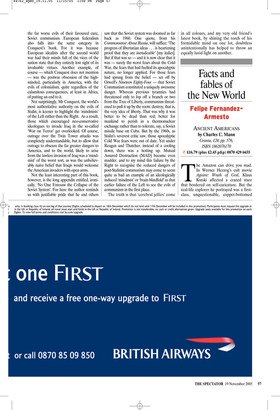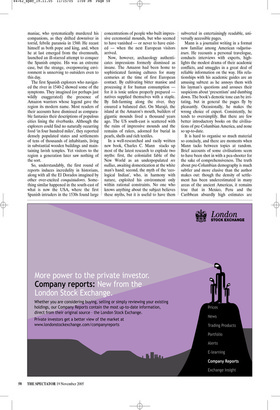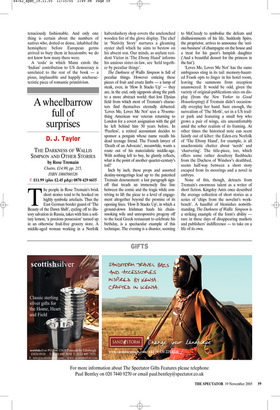Facts and fables of the New World
Felipe FernandezArmesto ANCIENT AMERICANS by Charles C. Mann Granta, £20, pp. 576, ISBN 1862076170 ✆ £16.79 (plus £2.45 p&p) 0870 429 6655 The Amazon can drive you mad. In Werner Herzog’s cult movie Aguirre: Wrath of God, Klaus Kinski affected a crazed stare that bordered on self-caricature. But the real-life explorer he portrayed was a firstclass, unquestionable, copper-bottomed maniac, who systematically murdered his companions, as they drifted downriver in torrid, febrile paranoia in 1560. He recast himself as both pope and king, and, when he at last emerged from the rivermouth, launched an ill-starred attempt to conquer the Spanish empire. His was an extreme case, but the strange, overpowering environment is unnerving to outsiders even to this day.
The first Spanish explorers who navigated the river in 1540-2 showed some of the symptoms. They imagined (or perhaps just wildly exaggerated) the presence of Amazon warriors whose legend gave the region its modern name. Most readers of their accounts have dismissed as comparable fantasies their descriptions of populous cities lining the riverbanks. Although the explorers could find no naturally occurring food ‘in four hundred miles’, they reported densely populated states and settlements of tens of thousands of inhabitants, living in substantial wooden buildings and maintaining lavish temples. Yet visitors to the region a generation later saw nothing of the sort.
So, understandably, the first round of reports induces incredulity in historians, along with all the El Dorados imagined by other over-excited conquistadores. Something similar happened in the south-east of what is now the USA, where the first Spanish intruders in the 1530s found large concentrations of people who built impressive ceremonial mounds, but who seemed to have vanished — or never to have existed — when the next European visitors arrived.
Now, however, archaeology authenticates impressions formerly dismissed as insane. The Amazon had been home to sophisticated farming cultures for many centuries at the time of first European contact. By cultivating bitter manioc and processing it for human consumption for it is toxic unless properly prepared natives supplied themselves with a staple. By fish-farming along the river, they ensured a balanced diet. On Marajó, the island at the Amazon’s mouth, builders of gigantic mounds lived a thousand years ago. The US south-east is scattered with the ruins of impressive mounds and the remains of rulers, adorned for burial in pearls, shells and rich textiles.
In a well-researched and racily written new book, Charles C. Mann stacks up most of the latest research to explode two myths: first, the colonialist fable of the New World as an underpopulated res nullius, awaiting domestication at the white man’s hand; second, the myth of the ‘ecological Indian’, who, in harmony with nature, exploited his environment only within rational constraints. No one who knows anything about the subject believes these myths, but it is useful to have them subverted in entertainingly readable, universally accessible pages.
Mann is a journalist writing in a format now familiar among American vulgarisateurs. He recounts a personal travelogue, conducts interviews with experts, highlights the modest drama of their academic conflicts, and smuggles in a great deal of reliable information on the way. His relationships with his academic guides are an amusing subtext as he annoys them with his layman’s questions and arouses their suspicions about ‘presentism’ and dumbing down. The book’s demotic tone can be irritating, but in general the pages fly by pleasantly. Occasionally, he makes the wrong choice of expert. Consistently, he tends to oversimplify. But there are few better introductory books on the civilisations of pre-Columbian America, and none so up-to-date.
It is hard to organise so much material so concisely, and there are moments when Mann tacks between topics at random. Brief accounts of some civilisations seem to have been shot in with a pea-shooter for the sake of comprehensiveness. The truth about pre-Columbian demography is much subtler and more elusive than the author makes out: though the density of settlement has been underestimated in many areas of the ancient Americas, it remains true that in Mexico, Peru and the Caribbean absurdly high estimates are tenaciously fashionable. And only one thing is certain about the numbers of natives who, dotted or dense, inhabited the hemisphere before European germs arrived to bury them in hecatombs: we do not know how many there were.
A ‘coda’ in which Mann extols the ‘Indian’ contribution to US democracy is unrelated to the rest of the book — a pious, implausible and happily uncharacteristic piece of romantic primitivism.



























































 Previous page
Previous page